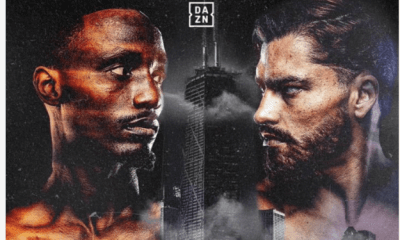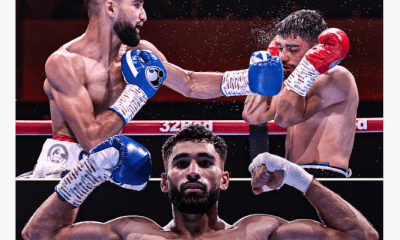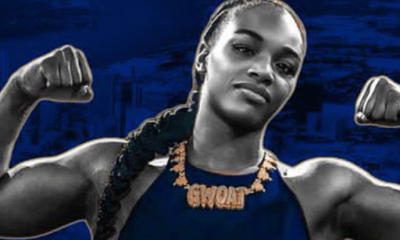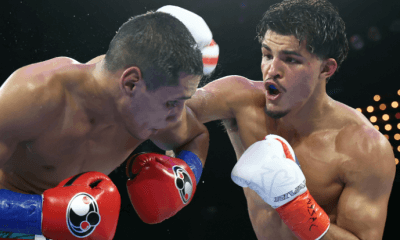Featured Articles
Underdog Showtime Won Its War With HBO, But the Victory Now Seems Hollow
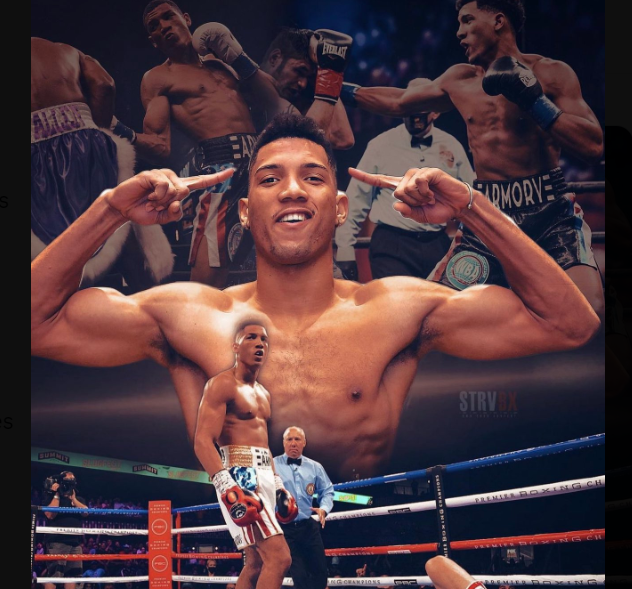
Underdog Showtime Won Its War With HBO, But the Victory Now Seems Hollow
Carthage finally has fallen.
Not that many boxing fans are apt to compare the former arch-rivalry of premium-cable outlets HBO and Showtime with the three Punic Wars pitting the Roman Empire against the formidable North African city-state of Carthage from 264 B.C. to 146 B.C., but the analogy fits when certain modifications are taken into consideration.
During the 32 years when HBO and Showtime went head-to-head in much the same manner of the fighters they showcased, the more-established, better-funded HBO was the figurative representative of Rome’s omnipresent might, with Showtime cast as the gritty, determined equivalent of Carthage. But a near-century of intermittent conflict ended as it surely had to, with Roman legions finally laying waste to the most persistent obstacle to the quest for absolute control of an expanding and insatiable empire.
But upsets can and do happen in boxing, and the Rome vs. Carthage script flipped at the end of 2018 when HBO quit on its stool after 45 years in the fight game, its once-well-financed commitment to being the industry leader ebbing incrementally at the behest of an increasingly disinterested corporate ownership.
“HBO is now a mature company, and the guys who care just about the numbers decided that boxing wasn’t popular enough to keep going,” longtime HBO commentator Larry Merchant said as the end of an era came with the sound of a death rattle. “They were putting fractions – small fractions – of the money into it that they used to put into it.”
“It’s sad to see it all go away by its own hand and their own decision-making,” added Lou DiBella, a senior vice president of HBO Sports until his departure in the fall of 2000. “This is like the Yankees going out of business in a way, in terms of a brand … You would have loved to see them go out on top, not with a whimper.”
The demise of HBO Boxing opened the door for a dramatic rise in prestige for Showtime Championship Boxing and its much-respected, star-making adjunct, ShoBox, whose administrators and broadcast talent reveled in their figurative elevation from Carthage to Rome. But, as Spanish philosopher George Santayana once observed, “Those who cannot remember the past are condemned to repeat it.”
Just as HBO had abdicated its lofty place in the boxing stratosphere five years earlier, the curtain came down on Showtime, by turns reminiscent of its scrappy underdog period and its later heyday as the foremost televised purveyor of the sweet science. As was the case with HBO, the cause of its demise likely can be traced to profit-and-loss figures on a spreadsheet, not the love of a sport that always has needed to be embraced for reasons that necessarily supersede priorities established by upper management and accountants with sharp pencils and MBA degrees.
Voicing the same sort of sad farewell that Merchant and DiBella had offered up when HBO took its leave in 2018 is Showtime’s David Dinkins Jr., the Senior Vice President and Executive Producer for the entire 37-year run of its boxing operation.
“We should be recognized for our pursuit of excellence and attention to detail,” Dinkins said in an interview with The Ring. In our prime we were without peer – the best coverage, live and replays, best commentary and the best presentation from the ring walks to post-fight interviews.”
Well, some deposed HBO Boxing alumni might argue that point, but the net effect of Showtime taking the 10-count opens a Pandora’s Box of uncertainty that surely will affect the way the sport is made available to the public going forward, possibly more than anyone can imagine in the here and now.
On Dec. 7, Prime Video and Premier Boxing Champions announced what they described as a “multiyear rights agreement,” with Prime Video included in the Amazon Prime membership package. A series of PBC Championship Boxing events will be streamed, including PBC pay-per-view shows. Given the fact that Prime Video has more than 150 million subscribers in the United States, as reported by Thomas Hauser, the first reaction might be that boxing, unlike Carthage, is too resilient to ever be destroyed. But every move away from established norms to something new requires a period of adjustment, for those assuming the burden of proprietorship as well as fight fans who long have been asked to part with chunks of their diminishing disposable income to feed their pugilistic addiction.
Let history record that Showtime Championship Boxing officially breathed its last at 11:26 p.m. EST when its closing credits finished rolling, not long after WBA super middleweight champion David Morrell Jr.’s second-round stoppage of Sena Agbeko became the answer to a future trivia question as to which bout shoveled the last spade of dirt onto a grave worthy of a polished marble headstone.
The tripleheader of televised fights, all won by southpaws, was a fitting farewell. The 25-year-old Morrell (10-0, 9 KOs) might seem too early in his professional career to have already logged five title defenses, but the transplant from steamy Cuba to the wintry frigidity of his adopted home base of Minneapolis was 130-2 as an amateur and has the look of a possible future superstar. Fighting for the sixth time in the comfy confines of the sold-out Armory (all 5,314 seats filled), Morrell (pictured) dispatched Agbeko (28-3, 22 KOs) with a display of power punching that had him clamoring for a non-alphabet championship matchup that conceivably could take place sometime in the about-to-become new year.
“In 2024, I want to fight Benavidez. One hundred percent,” Morrell said of a pairing for the all-David 168-pound crown, with a shot at undisputed super middleweight champ Canelo Alvarez presumably awaiting the winner. But Benavidez (28-0, 24 KOs) is coming off a sixth-round stoppage of Demetrius Andrade on Nov. 25 and is hopeful his next bout will be with Alvarez, without the necessity of going through Morrell first.
The co-main event, pitting Chris “Primetime” Colbert against Jose “Rayo” Valenzuela in a WBA lightweight eliminator, was a do-over of their closely contested and controversial first meeting on March 25 of this year, when Colbert overcame a first-round knockdown and a couple of other shaky rounds to pull out a unanimous decision by identical 95-94 scorecards from the three judges. Although Colbert said he’d never give “sore loser” Valenzuela a rematch, the opportunity to be a part of the historic Showtime exit card was too much for Colbert to say no to, although he may have come to regret his acquiescence.
The larger and stronger Valenzuela, as in their first bout, dropped Colbert in the first round and thereafter he waited for his opportunity to unveil a previously sheathed weapon, a right hook, whenever Colbert switched from orthodox to southpaw, which he did in the sixth round. With Colbert’s protective left hand down, Valenzuela flung himself forward to land a crushing hook that sent his opponent crashing to the canvas, unconscious, his head draped over the bottom stand of the ring ropes.
“The second time he turned left he saw I was gonna throw a jab so he could catch it up front, but I dipped a little bit and shot the right hook,” Valenzuela said of his put-away bomb.
After Colbert came to and met with Valenzuela in the center of the ring, he said, “We’re 1-1, let’s run this back.” That request didn’t gain any traction with Valenzuela, who said, “I beat him twice. I was patient for a reason. This was a title eliminator and I want to fight for a title. So Tank Davis (the WBA lightweight ruler), let’s get it on, man.”
The opener, pitting a pair of 40-year-old former world champions, was a rematch of a bout that took place 11 years earlier, when Robert “The Ghost” Guerrero (38-6-1, 20 KOs) scored a 12-round unanimous decision over Andre Berto (32-6, 24 KOs). The oldies-but-used-to-be goodies may not be all that they once were, but both showed sporadic flashes of their prime selves with Guerrero winning a wide 10-round unanimous decision.
Now that Showtime has joined HBO as boxing entities that are no more, it is worth mentioning that their frequent skirmishes behind the scenes were often as noteworthy as, say, the confrontations that paired aging promotional lions Don King and Bob Arum. One such incident took place in 2005, when I was president of the Boxing Writers Association of America.
The BWAA almost always has staged its annual awards dinner in New York City, but I concluded that Las Vegas was long overdue to be the host city for such an affair, but only if it could come in conjunction with a corresponding fight important enough to attract a sizable media gathering. Officials at both HBO and Showtime were made aware of the BWAA’s intentions and were given a time window in which a suitable bout could be arranged as an accompaniment for the awards dinner.
Jay Larkin, then the senior vice president and executive producer of Showtime Sports, was so enthused about his company’s possible participation that he vowed to up his normal budget for that particular show by a half-million dollars, with the Mandalay Bay to serve as the host venue for what proved to be the first matchup of Diego Corrales and Jose Luis Castillo on May 7, 2005. We shook hands and that was that. Or at least it should have been.
A few days later, someone purporting to be representing HBO – I should stress it was not someone directly affiliated with HBO – contacted me and said that HBO honchos had reconsidered and wanted in. The fight tie-in would have been at the MGM Grand on May 14, 2005, and featured Felix Trinidad against Winky Wright. That was nice, I said, but I already had agreed to the date with Showtime for the previous week.
“But did you sign a contract?” the guy asked. “If you didn’t sign a contract, you can switch to the following week. And Trinidad is a bigger name than the two guys on the Showtime card.”
“Maybe so, but I gave my word,” I replied. The way I was raised, if you give your word, that should count for something, and I wasn’t about to renege on a verbal agreement that, to my way of thinking, was as good as a signed, sealed and delivered piece of paper.
Not that anyone could have predicted how everything would shake out, but Corrales-Castillo I turned out to be an epic, Fight of the Year lollapalooza. The BWAA dinner at the Mandalay Bay the night before was also a smash hit, with a ring set up in the banquet hall that made for a photo op that included Sugar Ray Leonard, Oscar De La Hoya, Bernard Hopkins, James Toney, Vitali Klitschko, Chris Byrd, Shane Mosley, Winky Wright, Zab Judah, Hasim Rahman and master of ceremonies Jimmy Lennon Jr., among others. The following week, Trinidad turned in possibly the worst performance of his career in losing a one-sided, unanimous decision to Wright.
But the thing is, had HBO made the earliest proposal and I shook hands on it, that also would have been as good as a signed contract. Jay Larkin – who was fired by Showtime later in November 2005 because of job cutbacks, and died of brain cancer at the too-young age of 59 on Aug. 9, 2010 – kept his word to me, and I wish he had been included when Showtime’s closing credits rolled late Saturday night.
Carthage has fallen, probably forever, and I can only say that I will miss the in-fighting that took place when HBO and Showtime competed so fiercely that they made boxing, and their own operations, better. It was a grand time, often chaotic, but never lacking in entertainment. The sun still comes up every morning, but somehow the world seems just a bit different. Time will tell just how different, and whether those of us who love the sport of crooked noses and indomitable hearts will be satisfied with whatever comes next.
—
Bernard Fernandez, named to the International Boxing Hall of Fame in the Observer category with the Class of 2020, was the recipient of numerous awards for writing excellence during his 28-year career as a sports writer for the Philadelphia Daily News. “Championship Rounds, Round 4,” the fourth installment of Fernandez’s four-volume anthology, is now out and available via Amazon and other book-selling outlets.
To comment on this story in the Fight Forum CLICK HERE
-

 Featured Articles3 weeks ago
Featured Articles3 weeks agoResults and Recaps from New York Where Taylor Edged Serrano Once Again
-

 Featured Articles5 days ago
Featured Articles5 days agoThe Hauser Report: Zayas-Garcia, Pacquiao, Usyk, and the NYSAC
-

 Featured Articles3 weeks ago
Featured Articles3 weeks agoResults and Recaps from NYC where Hamzah Sheeraz was Spectacular
-

 Featured Articles4 weeks ago
Featured Articles4 weeks agoFrom a Sympathetic Figure to a Pariah: The Travails of Julio Cesar Chavez Jr
-

 Featured Articles2 weeks ago
Featured Articles2 weeks agoManny Pacquiao and Mario Barrios Fight to a Draw; Fundora stops Tim Tszyu
-

 Featured Articles3 weeks ago
Featured Articles3 weeks agoPhiladelphia Welterweight Gil Turner, a Phenom, Now Rests in an Unmarked Grave
-

 Featured Articles2 weeks ago
Featured Articles2 weeks agoArne’s Almanac: Pacquiao-Barrios Redux
-

 Featured Articles4 weeks ago
Featured Articles4 weeks agoCatterall vs Eubank Ends Prematurely; Catterall Wins a Technical Decision


